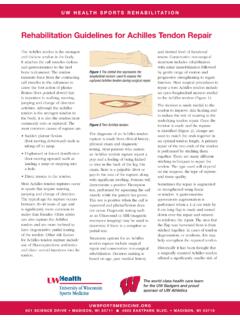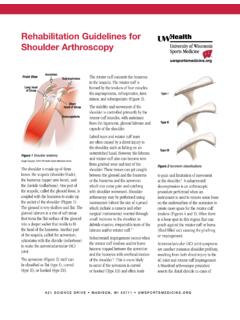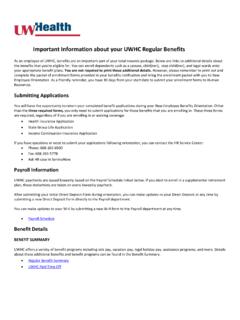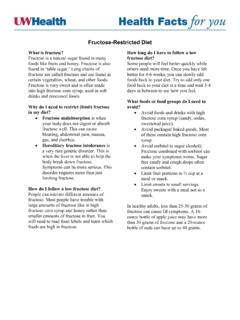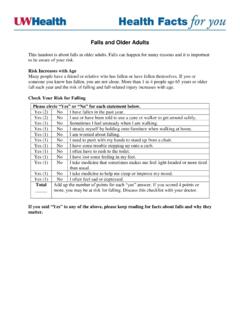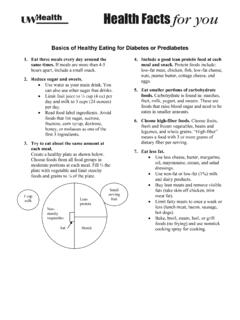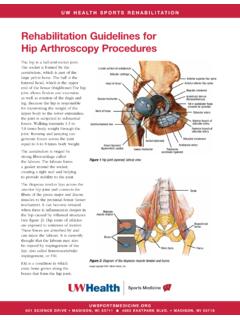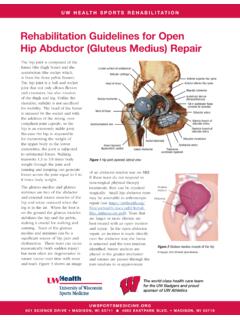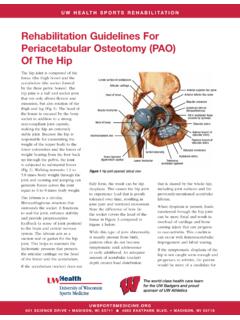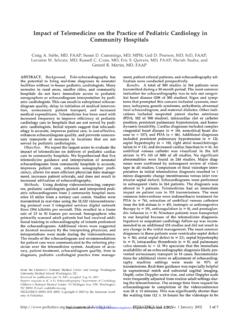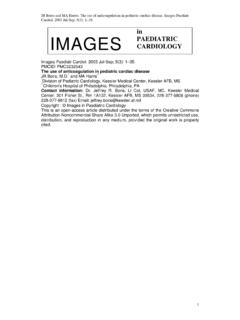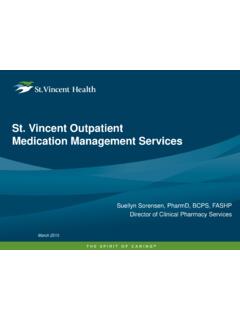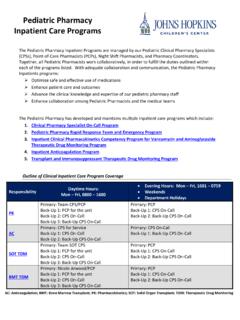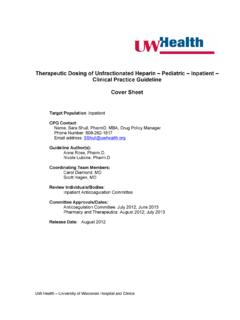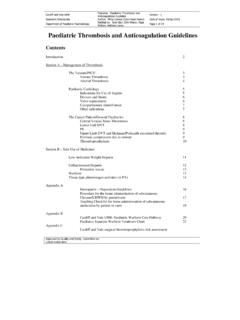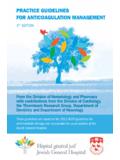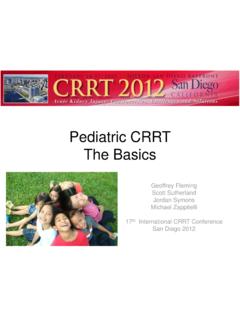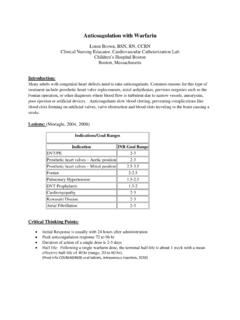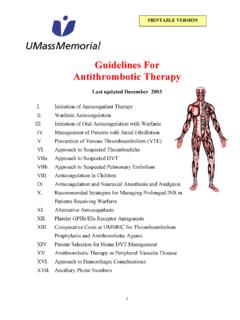Transcription of Therapeutic Dosing of Unfractionated Heparin - Neonatal ...
1 1 Therapeutic Dosing of Unfractionated Heparin - Neonatal / pediatric - inpatient clinical Practice Guideline Note: Active Table of Contents Click to follow link Table of Contents EXECUTIVE SUMMARY .. 3 SCOPE .. 4 METHODOLOGY .. 5 INTRODUCTION .. 5 RECOMMENDATIONS .. 5 UW HEALTH IMPLEMENTATION .. 7 APPENDIX A1 .. 8 REFERENCES .. 9 2 CPG Contact for Content: Name: Anne Rose, PharmD Pharmacy: anticoagulation Stewardship Phone Number: (608) 263-9738 Email Address: CPG Contact for Changes: Name: Philip Trapskin, PharmD, BCPS Drug Policy Program Phone Number: (608) 263-1328 Email Address: Guideline Author(s): Anne Rose, PharmD Pharmacy Nicole Lubcke, PharmD Pharmacy Coordinating Team Members: Carol Diamond, MD pediatric Hematology/Oncology Scott Hagen, MD pediatric Critical Care Deborah Soetenga, MS, RN, CCNS pediatric clinical Nurse Specialist Review Individuals/Bodies: Teresa Darcy, MD, MMM - Pathology inpatient anticoagulation Committee Committee Approvals/Dates: anticoagulation Committee: July 2012; June 2013.
2 November 2015 Pharmacy and Therapeutics: August 2012; November 2015 Release Date: November 2015 | Next Review Date: November 2018 3 Executive Summary Guideline Overview This clinical practice guideline is intended to provide a standardize process for the initiation, maintenance and monitoring of intravenous Unfractionated Heparin used for Therapeutic indications. practices considered include guidance on selection of initial Dosing nomograms, maintenance dose adjustments, laboratory monitoring and transitioning to alternative anticoagulants. Key Practice Recommendations 1. Initial Heparin Bolus Initial bolus dose of 75 units/kg will result in a Therapeutic anti-Xa in 90% of children Bolus doses are based on actual body weight Boluses should be used with caution or avoided in patients with the following: Neonates and premature neonates Stroke Active bleeding High bleeding risk 2.
3 Initiation of Heparin Infusion Initial infusion rate is based on the age of the child Document infusion rates in units/kg/hr Table 1. Initial Heparin Infusion Rates Age Bolus Dose (units/kg) Maximum Bolus (units) Initial Infusion (units/kg/hr) Birth to 12 months 75 1,500 28 Children > 1 year 75 5,000 20 Children > 12 years 80 10,000 18 3. Algorithm for adjusting Therapeutic Heparin infusion Table 2. Heparin Infusion Dose Adjustments Heparin Level by Anti-Xa (IU/mL) Bolus/Hold Infusion Rate Change < Bolus 50 units/kg 3 units/kg/hr 0 2 units/kg/hr - 0 No Change; Therapeutic Range - 0 by 2 unit/kg/hr Hold infusion 30 min by 2 units/kg/hr > Hold infusion 1 hour by 3 units/kg/hr Inform physician of each anti-Xa result for Heparin infusion rate adjustment Companion Documents 1.
4 IP/ED Heparin Anticoagulant pediatric Order Set Pertinent UW Health Policies & Procedures 1. UWHC Policy #: High Alert Medication Administration 4 Patient Resources 1. Health Facts For You #6915: Heparin ( Unfractionated and Low Molecular Weight) Scope Disease/Condition(s): Hospitalized Neonatal and pediatric patients receiving intravenous Unfractionated Heparin intended for Therapeutic Dosing . Intended Users: Physicians Advanced Practice Providers Fellows Residents Pharmacists Registered Nurses Objective(s): This clinical practice guideline is intended to provide a standardized process for the initiation, maintenance and monitoring of intravenous Heparin used for Therapeutic indications. Target Population: The recommendations within this guideline would apply to Neonatal and pediatric patients receiving intravenous Unfractionated Heparin infusions with the intent to titrate to a Therapeutic goal.
5 Interventions and practices Considered: The clinical interventions and practices recommended in this guideline are intended for patients receiving Therapeutic intravenous Unfractionated Heparin . practices considered include guidance on selection of initial Dosing nomograms, maintenance dose adjustments, laboratory monitoring and transitioning to alternative anticoagulants. Major Outcomes Considered: The major outcomes considered in this guideline are for the safe and effective Dosing of IV Unfractionated Heparin through the use of standardized Dosing and monitoring nomograms, and documentation. Efficacy is measured by achieving a Therapeutic goal within 24 hours of initiation and safety is measured by bleeding outcomes and critical values. Guideline Metrics: The anticoagulation Stewardship Program periodically completes a review of our intravenous Heparin infusion administrations.
6 This review is done to assess adherence to the Dosing and monitoring nomograms, assess time to achieving Therapeutic ranges, evaluate critical values, and bleeding outcomes. Additionally, PSN related to Heparin infusions are reviewed throughout the year. 5 Methodology A modified Grading of Recommendations Assessment, Development, and Evaluation (GRADE) developed by the American Heart Association and American College of cardiology Foundation has been used to assess the Quality and Strength of the Evidence in this clinical Practice Guideline (Appendix A).1 A literature search conducted in Pubmed was completed to include the following search terms: pediatrics, Unfractionated Heparin monitoring , and Heparin monitoring anti-Xa Introduction Unfractionated Heparin (UFH) is used intravenously when Therapeutic anticoagulation is warranted and low molecular weight Heparin is not a suitable option.
7 Intravenous UFH has an immediate onset of action but requires monitoring and infusion rate adjustments in order to achieve a targeted Therapeutic range2. Neonates and pediatric patients differ in their pharmacologic response to UFH3-6. The following guideline provides recommendations for how to initiate, dose adjust and monitor a UFH infusion in a Neonatal and pediatric patient. UFH is a high alert medication. An additional double-check is required as specified in Hospital Administrative Policy must be performed on all boluses, when IV pump programming is outside of the established IV pump decision support software (Alaris Guardrails ) limits, when a new bag of Heparin is hung and at each shift change. Recommendations UFH intravenous infusions with the intent for titration to a Therapeutic goal must be ordered via the IP/ED Heparin anticoagulation pediatric Supplemental Order Set.
8 Separate order sets are available for extracorporeal membrane oxygenation or ventricular assist devices. 1. Baseline monitoring of UFH infusions Collect baseline PT/INR prior to initiating UFH infusion if not already available (Class I, Level C) Collect baseline CBC and platelet prior to initiating UFH infusion if not already available (Class I, Level C) Labs should be drawn from a fresh venipuncture site prior to initiating UFH infusion (Class IIB, Level C) 2. Initiation of UFH infusion Initial bolus dose of 75 units/kg will result in a Therapeutic anti-Xa in 90% of children3 (Class IIb, Level C) Boluses doses are based on actual body weight (Class IIb, Level C) Round the bolus dose to the nearest 10 units for ease of preparation Use Heparin 1000 units/mL vial from floor stock for bolus dose See Table 1 for recommendations on bolus dose 6 Bolus doses should be used with caution or avoided in patients with the following3.
9 (Class I, Level C) Neonate or premature neonates Stroke Active bleeding High bleeding risk Initial starting infusion rate is based on the age of the patient3 Document infusion rate in unit/kg/hr See Table 1 for recommendations on initial infusion rate Table 1. Initial Heparin Bolus Dose and Infusion Rate3-6 (Class IIb, Level C) Age Bolus Dose (units/kg) Maximum Bolus (units) Initial Infusion (units/kg/hr) Birth to 12 months 75 1,500 28 Children > 1 year 75 5,000 20 Children > 12 years 80 10,000 18 3. Titration and monitoring of UFH infusion3,7-11 (Class IIb, Level C) Check STAT anti-Xa after initiation of the infusion and after any rate change Every 8 hours for children < 1 year of age Every 4 hours for children > 1 year of age Use the nomogram in Table 2 for UFH infusion rate adjustments Once 3 consecutive anti-Xa levels are Therapeutic it is recommended to check an anti-Xa level every 24 hours with the am labs If a rate adjustment becomes necessary or the infusion is held for any reason and restarted, recheck anti-Xa level and repeat the above process If a Therapeutic goal is not reached within 24 hours with correct titration the patient may not be an appropriate candidate for adjustments based on the Heparin algorithm.
10 Recommend consultation with Pharmacy and/or Hematology for assistance with Dosing . Table 2. Heparin Infusion Dose Adjustment Nomogram3,7-11 (Class IIb, Level C) Heparin Level by Anti-Xa (IU/mL) Bolus/Hold Infusion Rate Change < Bolus 50 units/kg 3 units/kg/hr 0 2 units/kg/hr - 0 No Change; Therapeutic Range - 0 by 2 unit/kg/hr Hold infusion 30 min by 2 units/kg/hr > Hold infusion 1 hour by 3 units/kg/hr Inform physician of each anti-Xa result for Heparin infusion rate adjustment 7 4. Additional monitoring2,3 (Class IIb, Level C) Samples should not be drawn from an IV infusing UFH Hemoglobin and platelets must be followed 24 hours after initiating UFH therapy and every other day thereafter for up to 14 days of until therapy is discontinued.
